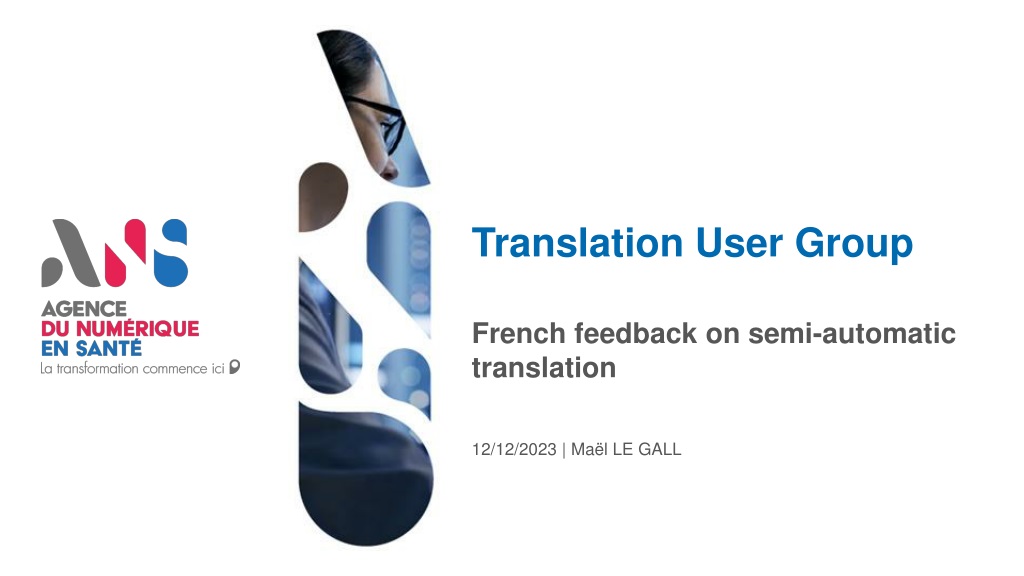

Replay
0 likes | 7 Views
Feedback on semi-automatic French translation processes highlights challenges such as spelling rectifications, body structure nomenclature changes, and organism hierarchy specificities. Strategies involve creating common French translations, utilizing various resources for improving translation quality, and emphasizing human validation in automatic translation efforts to ensure clarity and accuracy.

E N D
Translation User Group French feedback on semi-automatic translation 12/12/2023 | Maël LE GALL
Translation – A need and a requirement Translation as a need Ensure the deployment of SNOMED CT Facilitate the understanding and skill development of stakeholders Support the secondary use of data (NLP, NER, Data analytics…) Translation as a requirement Since 1994 all public entities or body exercising a public service mission must respect the Toubon Law on translation : Every document concerning a good or a service must be in French or translated in French 2 | TUG – French feedback on semi-automatic translation
CGTS – Health Terminologies Management Centre Interoperability CGTS Define norms and standards to structure data Publish reference Terminologies Support the development of semantic interoperability NRC 22 2 7 LOINC WHO Collaborative Centre 3 | TUG – French feedback on semi-automatic translation
Translation pipeline Based on translated Terminologies ICD-11 translation pipeline A translation by description Fr En 10.18653/v1/2020.louhi-1.7 rather than by concept ► This pipeline was fine-tuned for SNOMED CT translation (Terminology-based descriptions & homemade rules) 4 | TUG – French feedback on semi-automatic translation
French Translation Collaboration Group Goal Members of the group Create a common French translation that every country can use in its national edition. French-speaking NRCs ► Reduces the translation effort for every country ► Creates common translation rules Stakeholders (Private companies & hospitals) ► Enhances confidence in the validity of French translation Challenges faced 1 2 Rules were made for manual translation French spelling rectifications of 1990 were only recommended ► Not always implementable in an automatic translation process ► Difficulty to validate the behaviour of some implemented rules ► Presence of both spelling in corpora ► New spellings still not officially recognized as the main spelling by the French Academy 5 | TUG – French feedback on semi-automatic translation
Body structure challenges Change of nomenclature for some body structures SEP model translations led to unnatural translations and difficulty gender & number agreement to manage ► Presence of both nomenclature ► No French programmatically accessible source to identify the old and previous nomenclature ► “Entire X of Y” 16 variations Synonyms management Acronyms management Different synonyms in English can have the same meaning in French and vice-versa ► Same acronym but different meaning ► Different acronyms but same meaning Should we generate all possible synonyms? ► English acronyms without equivalence in French Balance between reducing cross validation time & increasing relevant synonyms amount for users 6 | TUG – French feedback on semi-automatic translation
Organism challenges Architecture quality (in progress thanks to Microbiology group) Organism hierarchy specificities ► The descriptions “are” the concept Quality of translation is dependent on hierarchy quality ► Non-FSN heterotypical and homotypical synonyms, historical names, … descriptions represent ► Taxonomic Latin Taxonomic Latin Domain specificity Identification of taxonomic Latin word in a term that do not need to be translated. Improvement of translation pipeline, by using : ► MeSH mapping ► Taxoniq Python library ► Wikipedia ► Google’s knowledge graphs 7 | TUG – French feedback on semi-automatic translation
Key messages ► Automatic translation is a great tool, but results require human validation ► Each hierarchy has its specificities and requires adjustment ► Quality and clarity of concept is essential to ensure quality of translation 8 | TUG – French feedback on semi-automatic translation